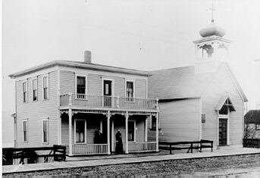On September 18, 1895, St. Spiridon Orthodox Church holds its first service for Greek, Russian, and Serb immigrants. About half the congregation of 100 is native-born American. The celebrant is an itinerant missionary, Father Sebastian Dabovich, who soon moves on.
Greek-born George and Mary Nicholas donated a lot at 817 Lakeview Avenue on Capitol Hill for the church, which was built with volunteer labor. According to Orthodox tradition, the altar was built on the east end of the building. This necessitated construction of a trestle to enter the building where it hung over a ravine at the west end. The first permanent priest was Father Dimitry Kamnev who held the first liturgical service on November 19, 1895. The building was remodeled in 1901 with funds from Czar Nicolas II of Russia. The Czar also provided a stipend to support the parish priest.
To accommodate the diverse congregation, priests had to be tri-lingual, in Greek, Russian, and English. By 1915, there were approximately 2,000 Greeks in Seattle, mostly men under the age of 25. The Greeks formed a separate congregation in 1918 when they obtained use of the Episcopal Church at Yale Avenue N and John Street (now Yale Avenue E and E John). The Greeks built St. Demetrios's Church in 1921 at Yale and Thomas.
Beginning in 1920, more than one million Russians fled the Bolshevik Revolution and the civil war. Six thousand Russians passed through Seattle in 1923. St. Spiridon was an important institution in helping the refugees to settle. In the 1920s, the Bolsheviks dispatched Father Vladimir Alexandrov to the United States to take control of Orthodox churches here. Because of the Russian government's financial support of the church, Father Alexandrov filed suit in King County Superior Court to take possession of St. Spiridon. Even though he won the suit, parishioners hostile to this move removed all property from inside the church. They formed St. Nicholas parish in 1935.
In 1941, St. Spiridon's built a new church at 400 Yale Avenue N (in Seattle's Cascade neighborhood at the south end of Lake Union), and it was designated a cathedral. Whereas the first St. Spiridon's followed a modified New England style, the new building resembled the churches of northern Russia.

